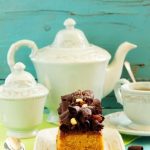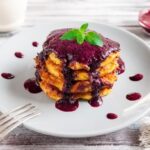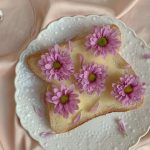The art of cake decorating is truly brought to life with the addition of frosting. Frosted cakes are not only visually appealing, but they also offer a delightful burst of flavor and texture. In this article, we will explore the world of frosting for decorating cakes and learn how to create not only beautiful designs but also enhance the taste and overall presentation.
Frosting plays a pivotal role in transforming a simple cake into a masterpiece. It serves as the canvas on which decorators can unleash their creativity and bring their visions to life. Whether you’re piping intricate designs or smoothing on a silky finish, well-made frosting can elevate any cake to new heights. From elegantly swirled buttercream to glossy ganache glazes, each type of frosting adds its own unique touch.
Aside from aesthetics, frosting adds an extra layer of delectable flavor to cakes. The velvety sweetness of buttercream, the tanginess of cream cheese icing, or the rich indulgence of chocolate ganache enhances the taste experience for every bite. Not only does it appeal to our sense of sight, but it also entices our taste buds.
Decorating cakes with frosting allows for limitless creative possibilities. It’s an opportunity for bakers and decorators alike to express themselves through color, texture, and design. Whether you’re creating whimsical birthday cakes or elegant wedding masterpieces, the excitement of exploring new techniques and experimenting with flavors is sure to ignite your passion for cake decoration.
Join us on this journey as we delve into different types of frostings, essential ingredients required for making them, step-by-step recipes, advanced decorative techniques, troubleshooting tips, and more. Unleash your creativity with homemade frosting and embark on an exciting adventure in the world of cake decoration. Let’s discover how to make stunningly beautiful and scrumptiously delicious treats that will leave everyone in awe.
Understanding Different Types of Frostings
When it comes to cake decoration, understanding the different types of frostings is essential. Each type has its own unique characteristics and uses, allowing you to select the right frosting based on the desired look, flavor, and occasion.
- Buttercream: Buttercream frosting is a classic choice known for its creamy texture and versatility. It is made with butter, powdered sugar, and flavorings such as vanilla or almond extract. Buttercream is perfect for creating smooth finishes and can be easily tinted with food coloring.
- Cream Cheese: Cream cheese frosting offers a tangy and rich flavor that pairs well with many cake flavors. It combines cream cheese, butter, powdered sugar, and vanilla extract. This frosting is commonly used for carrot cakes or red velvet cakes.
- Ganache: Ganache is a decadent frosting made from a mixture of chocolate and heavy cream. It creates a glossy finish that adds elegance to any cake. Ganache can be poured over the cake for an indulgent coating or whipped to create a lighter texture.
- Royal Icing: Royal icing is a thick, sweet icing that dries hard when exposed to air. It is made from powdered sugar and egg whites or meringue powder. Royal icing is commonly used for intricate decorations like flowers, borders, or piped designs.
By understanding the different types of frostings available, you can choose the one that best suits your cake decoration needs. Whether you’re looking for a smooth finish or intricate designs, there’s a frosting out there that will take your cake decorating skills to the next level.
Selecting the Right Frosting
When selecting the right frosting for your cake, there are several factors to consider. Think about the overall look you want to achieve and the flavor profile that will complement your cake.
- Look: If you desire a smooth and polished finish, buttercream or ganache would be great choices. For intricate designs or piping work, royal icing is the way to go.
- Flavor: Consider the flavor of your cake and how well it will pair with different frostings. Cream cheese frosting works wonderfully with carrot cakes or other flavors that have a spiced element.
- Occasion: The occasion can also influence your choice of frosting. For example, if you’re making a birthday cake for a child, bright and colorful buttercream could be the perfect option.
By considering these factors, you’ll be able to select the frosting that not only looks great but also enhances the taste of your cake. Experimenting with different types of frostings can open up a world of creativity and elevate your cake decoration skills to new heights.
Essential Ingredients for Making Frosting
When it comes to making frosting for decorating cakes, having the right ingredients is crucial. The quality and freshness of these ingredients can greatly impact the final taste and texture of your frosting. Here are the essential ingredients you’ll need to create delicious and visually appealing frostings:
- Sugar: Granulated sugar is a staple ingredient in most frosting recipes. It adds sweetness and helps to stabilize the frosting.
- Butter: Buttercream frostings typically call for unsalted butter, as it allows you to control the amount of salt in the recipe. Make sure to use softened butter that is at room temperature for easier blending.
- Powdered sugar: Also known as confectioners’ sugar or icing sugar, this finely ground sugar dissolves easily when mixed with other ingredients, resulting in a smooth and creamy texture.
- Vanilla extract: This flavorful ingredient adds depth and enhances the overall taste of the frosting. Pure vanilla extract is recommended for the best flavor.
- Milk or heavy cream: Liquid ingredients like milk or heavy cream are used to achieve the desired consistency of your frosting. They also help to make it easier to spread or pipe onto your cake.
It’s important to note that using high-quality ingredients will yield better results in your homemade frosting. Opt for fresh butter, good quality vanilla extract, and premium powdered sugar whenever possible. Additionally, storing your ingredients properly can help maintain their freshness. Keep your butter refrigerated until ready to use, store powdered sugar in an airtight container in a cool pantry, and check expiration dates on milk or heavy cream.
By using these essential ingredients and taking care with their selection and storage, you’ll ensure that your homemade frosting is not only visually appealing but also incredibly delicious.
Basic Buttercream Frosting Recipe
Making a basic buttercream frosting is a fundamental skill for any aspiring cake decorator. Whether you are a beginner or have some experience in frosting cakes, mastering this classic recipe is a must. In this section, we will provide you with a step-by-step guide to creating a delicious and versatile buttercream frosting that can be used for all your cake decorating needs.
Ingredients and Measurements
To make the basic buttercream frosting, you will need the following ingredients:
- 1 cup (2 sticks) unsalted butter, at room temperature.
- 4 cups powdered sugar.
- 1 teaspoon vanilla extract.
- 2 tablespoons milk or heavy cream.
Instructions
- Step 1: Begin by beating the softened butter in a mixing bowl until smooth and creamy. Using an electric mixer on medium speed is recommended for best results.
- Step 2: Gradually add the powdered sugar to the mixing bowl, about one cup at a time, beating well after each addition. This helps prevent lumps and ensures a smooth consistency.
- Step 3: Once all the powdered sugar has been incorporated into the butter, add the vanilla extract and milk (or heavy cream). Continue to beat on medium speed until everything is well combined and the frosting reaches your desired consistency. You may need to adjust the amount of milk/cream depending on how thick or thin you want your frosting to be.
Tips for Achieving Perfect Buttercream Frosting
- It’s important to use unsalted butter as salted butter can alter the taste of your frosting.
- Make sure your butter is at room temperature before starting. Softened butter blends more easily and results in smoother frosting.
- Sift your powdered sugar before adding it to the butter. This helps remove any lumps and ensures a silky texture.
- In addition to vanilla extract, you can experiment with other flavorings such as almond or lemon extract to customize the taste of your frosting.
- Once your buttercream frosting is ready, cover it tightly with plastic wrap or transfer it to an airtight container. It can be stored in the refrigerator for up to one week or in the freezer for up to three months.
Now that you have mastered the basic buttercream frosting recipe, you are well-equipped to start decorating cakes with confidence. This versatile frosting can be easily colored and flavored to suit any occasion or theme. Whether you are piping intricate designs or simply spreading it onto a cake, homemade buttercream frosting will elevate your creations and delight everyone who tastes them. So unleash your creativity and enjoy the process of making beautifully decorated cakes.
Exploring Variations and Flavors
When it comes to decorating cakes, one of the most exciting aspects is experimenting with different variations and flavors of frosting. Adding unique colors, flavors, and textures can take your cake decoration skills to the next level. In this section, we will explore various ways to enhance your frosting, allowing you to create stunning and delicious masterpieces.
Coloring your frosting can instantly transform a plain cake into a vibrant work of art. Natural food coloring or gel-based colors are excellent options for achieving bright and bold hues without altering the taste or consistency of the frosting. A helpful tip is to start with a small amount of color and gradually add more until you achieve the desired shade.
In addition to color, you can also infuse your frosting with various flavors to complement your cake. Liven up classic buttercream frosting by incorporating different flavorings such as extracts or fruit purees. For example, adding a touch of strawberry puree creates a luscious pink strawberry buttercream that pairs perfectly with vanilla or chocolate cakes. Experimenting with different combinations will allow you to personalize your creations and cater to specific tastes.
Furthermore, you can get creative by adding ingredients like chocolate, coffee, or spices to your frostings for unique taste profiles. If you’re a fan of all things chocolate, try incorporating cocoa powder or melted chocolate into buttercream frosting for an indulgent treat. Coffee lovers may enjoy adding some instant espresso powder or brewed coffee for a rich mocha flavor. Adding spices like cinnamon, nutmeg, or cardamom can also elevate your frostings with warm and aromatic notes.
To aid in visually appealing cake decorations, it’s important not only to consider flavor but also texture. By adjusting the amount of powdered sugar in traditional buttercream recipes, you can create frostings ranging from light and fluffy to dense and firm for piping intricate designs.
| Variations and Flavors | Benefits |
|---|---|
| Coloring with natural food coloring or gel-based colors | Transform plain cakes with vibrant hues |
| Incorporating different flavorings such as extracts and fruit purees | Create personalized frostings that complement the cake’s flavor |
| Adding chocolate, coffee, or spices for unique taste profiles | Elevate frostings with indulgent, rich, or aromatic flavors |
As you experiment with variations and flavors in your frosting, remember to keep track of your recipe adjustments so you can recreate successful combinations in the future. With a wide array of creative options at your fingertips, you can unleash your imagination and delight friends and family with beautifully decorated cakes that are just as scrumptious as they are visually stunning.
Advanced Decorative Frosting Techniques
Introduction to Advanced Decorative Frosting Techniques
Once you have mastered the basics of making frosting and creating a smooth finish on your cakes, it’s time to take your cake decorating skills to the next level with advanced decorative frosting techniques. Whether you want to impress your friends and family with beautifully piped designs or create intricate patterns and flowers, these techniques will help you elevate your cake decoration game.
Essential Tools for Decorating Cakes
Before diving into advanced frosting techniques, it’s important to have the right tools on hand. Piping bags are an essential tool for creating elaborate designs on your cakes. Made of fabric or disposable plastic, piping bags allow you to control the flow of frosting as you pipe it onto the cake. To achieve different effects, consider investing in a variety of piping tips, such as star tips for creating rosettes or round tips for outlining and writing.
In addition to piping bags and tips, other tools that can enhance your decorative skills include a turntable to easily rotate the cake while decorating, an offset spatula for smooth finishes, and a bench scraper for crisp edges. Having these tools readily available will make it easier for you to experiment and achieve professional-looking results.
Step-by-Step Guide to Advanced Techniques
Now that you have gathered all the necessary tools, let’s dive into some advanced decorative frosting techniques:
- Borders: Creating decorative borders is a simple yet effective way to add flair to your cakes. Start by selecting a piping tip that matches your desired border design. Hold the bag at a 45-degree angle above the cake and apply steady pressure while guiding the tip along the edge of the cake. Experiment with different designs such as shells, scallops, or braids to add visual interest.
- Rosettes: Rosettes are stunning flower-like designs that can instantly elevate any cake. Begin by using a star tip, starting from the center of the cake and spiraling outwards while applying consistent pressure to create a swirl. Continue piping additional layers of swirls until you achieve the desired size. You can make single rosettes or create cascading arrangements for an elegant touch.
- Piped Designs: If you’re feeling creative, piped designs can add whimsy and personality to your cakes. With just a little practice, you can pipe intricate patterns such as lacework or basketweave onto your cakes. Start by sketching your desired design onto parchment paper and then use it as a guide while piping directly onto the cake with a small round tip. Remember to apply even pressure and maintain a steady hand for clean lines.
By incorporating these advanced decorative frosting techniques into your cake decorating repertoire, you’ll be able to create show-stopping cakes that will impress both visually and in taste. Don’t be afraid to experiment with different designs and techniques – after all, the art of cake decoration is about unleashing your creativity and having fun.
Troubleshooting and Tips for Perfect Frosting
Creating the perfect frosting for decorating cakes can sometimes be a challenging task. From achieving the right consistency to overcoming common mistakes, it’s important to troubleshoot any issues that may arise. In this section, we will discuss some common troubleshooting tips and expert advice for perfecting your frosting.
One common issue when making frosting is when it turns out too thin or runny. This can happen if you add too much liquid or if the butter is too soft. To fix this, you can gradually add more powdered sugar until the desired consistency is reached. If the butter was too soft, you can also try refrigerating the frosting for a short period of time to firm it up.
On the other hand, if your frosting turns out too thick and difficult to spread or pipe, you can easily adjust the consistency by adding small amounts of milk or cream. Add them gradually while mixing until you reach the desired texture. Another tip is to make sure that your butter is at room temperature before starting to avoid lumps in your frosting.
Not being able to achieve smooth and flawless frosting finishes can be frustrating as well. If your frosting appears grainy or lumpy, it might be because of insufficient mixing or not using an electric mixer. Taking the time to beat the ingredients thoroughly will help create a smooth texture.
| Issue | Possible Solution |
|---|---|
| Frosting too thin/runny | Add more powdered sugar gradually until desired consistency is reached. Refrigerate briefly if butter is too soft. |
| Frosting too thick | Add small amounts of milk or cream gradually until desired consistency is achieved. Ensure butter is at room temperature before starting. |
| Frosting appears grainy or lumpy | Mix the ingredients thoroughly using an electric mixer to achieve a smooth texture. |
By following these troubleshooting tips and utilizing the expert advice shared, you can overcome any challenges you may face when making frosting. With a little patience and practice, you’ll be able to create perfect frosting every time, allowing your cake decorations to truly shine.
Storing and Preserving Frosted Cakes
Preserving the freshness and appearance of your beautifully decorated cakes is crucial after putting so much time and effort into creating them. Proper storage techniques will ensure that your cake stays delicious and visually appealing for as long as possible. Here are some tips to help you store and preserve your frosted cakes:
- Refrigeration: In most cases, it is best to refrigerate your frosted cake to keep it fresh. This is especially important if your frosting contains perishable ingredients like cream cheese or whipped cream. However, before placing the cake in the refrigerator, make sure it has completely cooled down to prevent condensation from forming on the frosting.
- Covering: When storing a frosted cake in the refrigerator, it is essential to cover it properly to prevent drying out or absorbing any unwanted flavors from other foods in the fridge. Use a cake dome or an airtight container large enough to accommodate the entire cake without touching the frosting. If you don’t have a suitable container, cover the cake tightly with plastic wrap.
- Avoiding Common Storage Mishaps: To avoid any mishaps during storage, be careful not to place anything heavy on top of your frosted cake as it may cause damage or smudge the design. Also, make sure that there is enough space in your refrigerator so that nothing touches the sides of the cake.
- Preserving Decorative Elements: Delicate decorative elements such as fondant decorations, sugar flowers, or piped designs need special attention when storing a frosted cake. It is best to store these cakes at room temperature since refrigeration can cause them to become soft or lose their shape. If necessary, you can refrigerate these cakes for short periods but always bring them back to room temperature before serving.
By following these storage tips and techniques, you can help maintain the freshness and beauty of your frosted cakes for several days. Remember to check the specific storage requirements of your frosting recipe as certain types may have different needs. With proper care and preservation, you can enjoy your delicious creations for days after the decorating process is complete.
Conclusion
In conclusion, homemade frosting is an essential element in cake decoration that plays a significant role in creating visually appealing cakes. It not only enhances the taste but also adds to the overall presentation of the cake. By understanding the different types of frostings and selecting the right one based on the desired look, flavor, and occasion, you can elevate your cake decorating game.
Making frosting from scratch requires essential ingredients, and it is crucial to use high-quality ingredients for optimal results. By carefully selecting and storing these ingredients, you can ensure freshness and enhance the flavor of your frosting. Additionally, following a basic buttercream frosting recipe with accurate measurements and proportions will help you achieve the perfect consistency and taste.
Moreover, exploring variations and flavors in frosting opens up endless possibilities for creativity. Adding natural food coloring or gel-based colors can bring vibrant hues to your creations, while incorporating different flavorings such as extracts or fruit purees can offer unique taste profiles. You can even experiment with chocolate, coffee, or spices to add a twist to traditional recipes.
By learning advanced decorative frosting techniques like borders, rosettes, piped designs, patterns, flowers, or other intricate elements, you can take your cake decorating skills to new heights. The use of piping bags, tips, and other essential tools will assist you in achieving professional-looking finishes.
Frequently Asked Questions
What kind of frosting is best for decorating cakes?
The best kind of frosting for decorating cakes depends on the desired outcome and personal preference. One popular option is buttercream frosting, which is made with butter, powdered sugar, and flavorings such as vanilla or chocolate. This type of frosting is versatile and can be easily tinted or flavored to match the theme or taste of the cake.
Its smooth consistency makes it suitable for piping decorations, creating borders, or covering the entire cake with a smooth finish. Another popular choice is cream cheese frosting, which adds a tangy flavor and creamy texture to cakes. It pairs well with flavors like carrot or red velvet and can also be piped or spread onto cakes for decorative effects.
How to make a cake frosting at home?
Making cake frosting at home allows for customization and offers a fresher taste compared to store-bought options. A basic recipe for buttercream frosting involves beating softened butter until creamy, gradually adding powdered sugar, and then mixing in any desired flavorings such as vanilla extract or cocoa powder. For a thinner consistency, a small amount of milk or cream can be added to achieve a spreadable consistency that is easy to work with when decorating.
Cream cheese frosting typically requires creaming together softened cream cheese and butter before gradually adding powdered sugar and flavorings like vanilla extract. It’s important to carefully follow measurements and instructions in order to achieve the desired texture and taste.
Which frosting is best for beginners?
For beginners, a good frosting option would be buttercream due to its simplicity in both ingredients and technique. Buttercream frosting is typically made by beating softened butter with powdered sugar until light and fluffy, making it easier to handle compared to other frostings that require more complex steps like cooking egg whites or melting chocolate. Buttercream also allows beginners to practice basic piping techniques using simple tips such as star tips or round tips without worrying about intricate designs initially.
Additionally, its forgiving nature makes it easy to fix any mistakes or inconsistencies while practicing cake decorating skills. As beginners gain confidence and experience, they can explore other types of frostings and experiment with more advanced techniques.

Welcome to my blog about home and family. This blog is a place where I will share my thoughts, ideas, and experiences related to these important topics. I am a stay-at-home mom with two young children. I hope you enjoy reading it! and may find some helpful tips and ideas that will make your home and family life even better!





